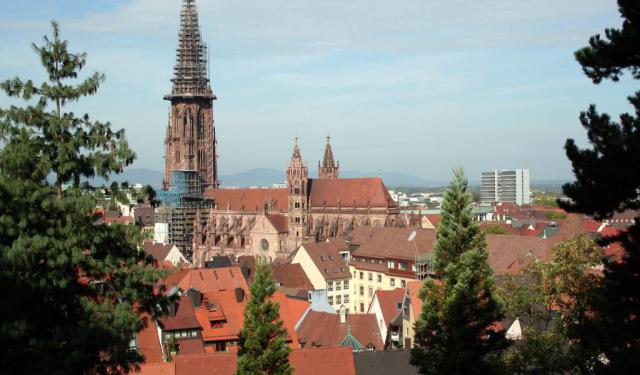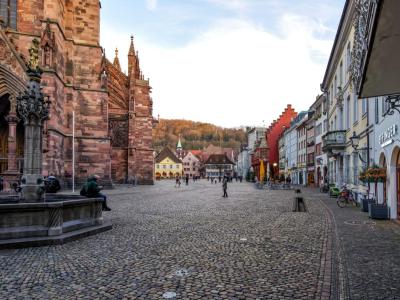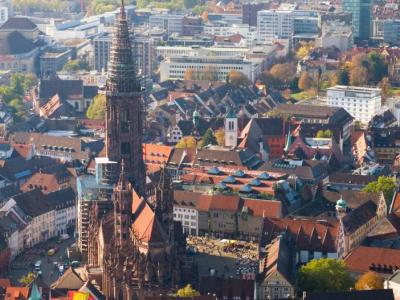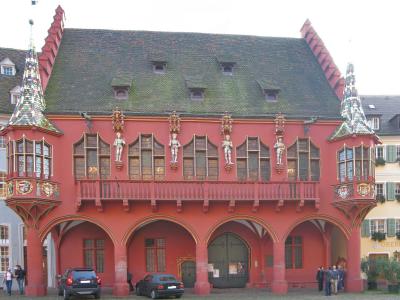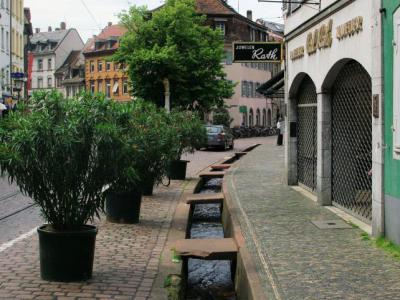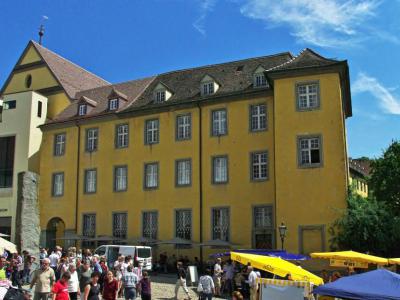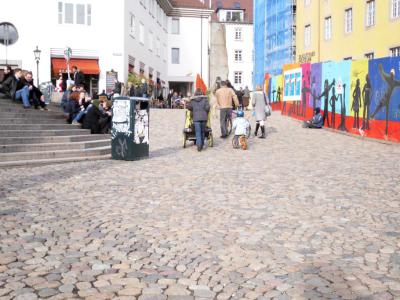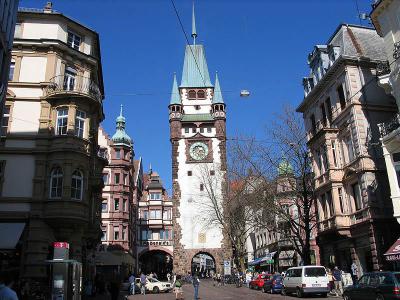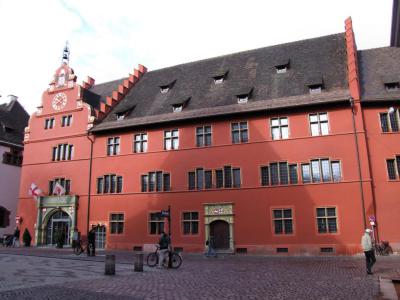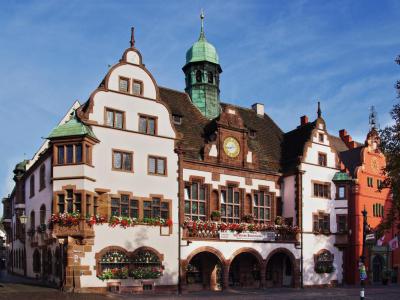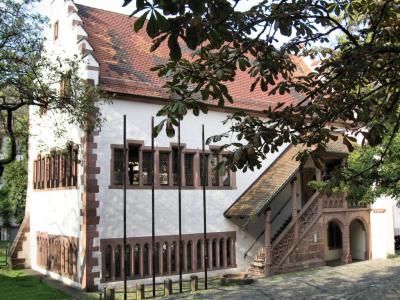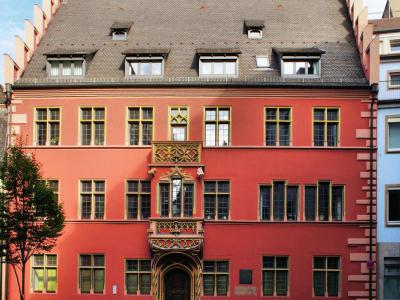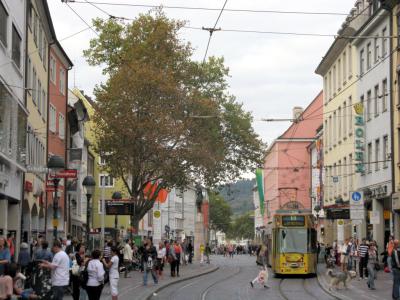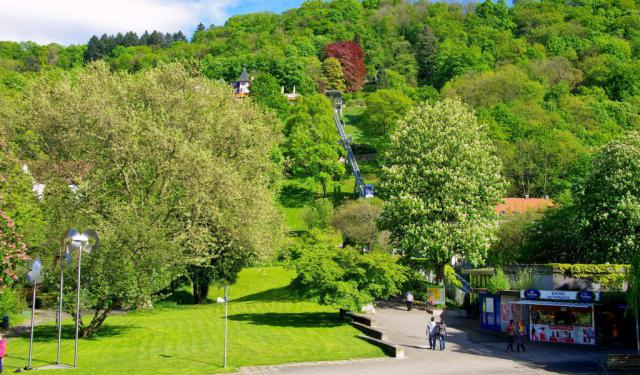Freiburg Introduction Walking Tour (Self Guided), Freiburg
Freiburg im Breisgau, more often referred to simply as Freiburg, is a lovely town in Baden-Württemberg in South West Germany (not to be confused with the other Freiberg in Saxony). Nestled at the foot of the tree-covered Castle Mountain (Schlossberg) since the 12th century, Freiburg is steeped in history, seemingly "whispering through its cobblestone streets." Its picturesque medieval architecture complete with natural attractions, such as the Dreisam River passing through the city and the Black Forest right on its doorstep, contribute to Freiburg's charming allure.
The name "Freiburg" signifies its origin as a free market town founded in 1120 by Konrad and Duke Berthold III of the House of Zähringen. The words "Frei" (for "free") and "Burg" (for "town") reflect its status as an "independent fortified town of free citizens".
As it grew, Freiburg became a bustling hub of trade, strategically positioned at the crossroads of major European commercial routes. Freiburg's transition from mining wealth to a center for arts, sciences, and commerce marked its evolution during the Renaissance. In 1457, Albert Ludwig University, one of Germany's oldest universities, was established here.
Despite its cultural achievements, Freiburg witnessed dark times, including witch hunts and the devastation of the Black Plague. The city also played a role in the Thirty Years' War in the early 17th century, enduring significant population losses. World War II brought its share of tragedy, too, with bombings and the deportation of the local Jewish population. Post-war, Freiburg was rebuilt on its medieval layout, largely retaining its historic charm.
One of the city's most iconic landmarks is the Freiburg Minster, "a soaring masterpiece of stone and spirit." This awe-inspiring cathedral, initiated in Romanesque style and completed in Gothic splendor by 1513, graces the Minster Square. Nearby, the Minster Market offers a glimpse into the city's vibrant culture, with stalls selling fresh produce and local crafts.
The historic Merchants' Hall, a picturesque 16th-century building with its characteristic red façade, is another testament to Freiburg's storied past. Freiburg's unique charm is further accentuated by its meandering waterways known as the Freiburg Bächle. These historic streams, originally constructed in the Middle Ages, traverse the city, adding to its enchanting atmosphere.
A true gem of a city, Freiburg is often overlooked for more full-on German destinations like Munich, Berlin, Cologne, or Frankfurt. This is probably because the Germans rather like to keep it to themselves:) To give it the deserved share of attention, we hereby invite you to a self-guided journey through this enchanting destination, whose enduring spirit and resilience make it a destination not to be missed!
The name "Freiburg" signifies its origin as a free market town founded in 1120 by Konrad and Duke Berthold III of the House of Zähringen. The words "Frei" (for "free") and "Burg" (for "town") reflect its status as an "independent fortified town of free citizens".
As it grew, Freiburg became a bustling hub of trade, strategically positioned at the crossroads of major European commercial routes. Freiburg's transition from mining wealth to a center for arts, sciences, and commerce marked its evolution during the Renaissance. In 1457, Albert Ludwig University, one of Germany's oldest universities, was established here.
Despite its cultural achievements, Freiburg witnessed dark times, including witch hunts and the devastation of the Black Plague. The city also played a role in the Thirty Years' War in the early 17th century, enduring significant population losses. World War II brought its share of tragedy, too, with bombings and the deportation of the local Jewish population. Post-war, Freiburg was rebuilt on its medieval layout, largely retaining its historic charm.
One of the city's most iconic landmarks is the Freiburg Minster, "a soaring masterpiece of stone and spirit." This awe-inspiring cathedral, initiated in Romanesque style and completed in Gothic splendor by 1513, graces the Minster Square. Nearby, the Minster Market offers a glimpse into the city's vibrant culture, with stalls selling fresh produce and local crafts.
The historic Merchants' Hall, a picturesque 16th-century building with its characteristic red façade, is another testament to Freiburg's storied past. Freiburg's unique charm is further accentuated by its meandering waterways known as the Freiburg Bächle. These historic streams, originally constructed in the Middle Ages, traverse the city, adding to its enchanting atmosphere.
A true gem of a city, Freiburg is often overlooked for more full-on German destinations like Munich, Berlin, Cologne, or Frankfurt. This is probably because the Germans rather like to keep it to themselves:) To give it the deserved share of attention, we hereby invite you to a self-guided journey through this enchanting destination, whose enduring spirit and resilience make it a destination not to be missed!
How it works: Download the app "GPSmyCity: Walks in 1K+ Cities" from Apple App Store or Google Play Store to your mobile phone or tablet. The app turns your mobile device into a personal tour guide and its built-in GPS navigation functions guide you from one tour stop to next. The app works offline, so no data plan is needed when traveling abroad.
Freiburg Introduction Walking Tour Map
Guide Name: Freiburg Introduction Walking Tour
Guide Location: Germany » Freiburg (See other walking tours in Freiburg)
Guide Type: Self-guided Walking Tour (Sightseeing)
# of Attractions: 12
Tour Duration: 2 Hour(s)
Travel Distance: 1.7 Km or 1.1 Miles
Author: DanaOffice
Sight(s) Featured in This Guide:
Guide Location: Germany » Freiburg (See other walking tours in Freiburg)
Guide Type: Self-guided Walking Tour (Sightseeing)
# of Attractions: 12
Tour Duration: 2 Hour(s)
Travel Distance: 1.7 Km or 1.1 Miles
Author: DanaOffice
Sight(s) Featured in This Guide:
- Minster Square and Minster Market
- Freiburg Minster (Cathedral)
- Historical Merchants' Hall
- Freiburg Bächle (Freiburg Streams)
- Augustiner Museum
- Agustinerplatz (Augustinians Square)
- Martinstor (Martin's Gate)
- Altes Rathaus (Old Town Hall)
- Neues Rathaus (New Town Hall)
- Gerichtslaube (Court House)
- Haus zum Walfisch (The Whale House)
- Kaiser-Joseph-Straße (Kaiser-Joseph Street)
1) Minster Square and Minster Market (must see)
The Minster Square is a picturesque cobblestone square that captures the city's charm and history. Surrounded by historic buildings, some meticulously reconstructed after the ravages of World War II, this square exudes timeless elegance. Among these buildings is the venerable Wentzingerhaus, a testament to the city's enduring spirit.
One notable survivor of the wartime bombings is the striking red Merchants' Hall, a proud reminder of the city's heritage and resilience. It stands as a symbol of Freiburg's ability to preserve its rich history.
Münsterplatz is not only a feast for the eyes but also a treat for the senses, as it hosts Münstermarkt, Freiburg's vibrant food market. This bustling market is a hub of daily activity, offering a delightful glimpse into the city's culture. Nestled in the shadow of the grand Freiburger Münster cathedral, Münstermarkt is a must-visit destination and one of the most enjoyable experiences in Freiburg.
From Monday to Saturday, the square comes alive with the presence of Freiburg's iconic sausage carts, where delectable wursts await eager patrons. These carts, flanking the square near the church, are surrounded by an array of vendors offering fresh flowers, local produce, wines, and delectable foods.
With over 150 stalls to explore, Münstermarkt is the perfect place for a street food lunch, a taste of the region's culinary delights, and a chance to pick up unique souvenirs. Among the many culinary delights, savoring a "Lange Rote," Freiburg's renowned bratwurst, in the charming ambiance of Münsterplatz is an experience not to be missed.
Münsterplatz, with its historic backdrop and bustling market atmosphere, stands as a vibrant centerpiece in the heart of Freiburg, inviting both locals and visitors to immerse themselves in the city's rich heritage and culinary traditions.
One notable survivor of the wartime bombings is the striking red Merchants' Hall, a proud reminder of the city's heritage and resilience. It stands as a symbol of Freiburg's ability to preserve its rich history.
Münsterplatz is not only a feast for the eyes but also a treat for the senses, as it hosts Münstermarkt, Freiburg's vibrant food market. This bustling market is a hub of daily activity, offering a delightful glimpse into the city's culture. Nestled in the shadow of the grand Freiburger Münster cathedral, Münstermarkt is a must-visit destination and one of the most enjoyable experiences in Freiburg.
From Monday to Saturday, the square comes alive with the presence of Freiburg's iconic sausage carts, where delectable wursts await eager patrons. These carts, flanking the square near the church, are surrounded by an array of vendors offering fresh flowers, local produce, wines, and delectable foods.
With over 150 stalls to explore, Münstermarkt is the perfect place for a street food lunch, a taste of the region's culinary delights, and a chance to pick up unique souvenirs. Among the many culinary delights, savoring a "Lange Rote," Freiburg's renowned bratwurst, in the charming ambiance of Münsterplatz is an experience not to be missed.
Münsterplatz, with its historic backdrop and bustling market atmosphere, stands as a vibrant centerpiece in the heart of Freiburg, inviting both locals and visitors to immerse themselves in the city's rich heritage and culinary traditions.
2) Freiburg Minster (Cathedral) (must see)
Freiburg Minster is a magnificent cathedral that bears witness to centuries of architectural evolution and history. The cathedral's origins can be traced back to around 1200 when it was initiated by the last duke of Zähringen, designed in the Romanesque architectural style of the time. However, in 1230, the cathedral underwent a significant transformation, adopting the graceful and soaring lines of the Gothic architectural style that characterize it today.
Remarkably, Freiburg Minster was constructed in part on the foundations of an original church dating back to the inception of Freiburg in 1120. Its most striking feature is the 116-meter tower, which boasts a nearly square base. At its center, you'll find the dodecagonal star gallery. Above this gallery, the tower takes on an octagonal and tapered shape, culminating in a towering spire that pierces the sky. This imposing tower houses 16 bells, with the oldest being the "Hosanna" bell cast in 1258, weighing a substantial 3,290 kilograms. The sonorous toll of this bell resonates through the city on various occasions, including Thursday evenings, Friday mornings, Saturday evenings, and annually on November 27th in remembrance of a historic air raid.
Inside the cathedral, two remarkable altars grace the sacred space: the high altar, a masterpiece crafted by Hans Baldung, and another altar created by the renowned artist Hans Holbein the Younger, found in a side chapel. As you step through the inner portal, you'll be greeted by intricate sculptures depicting the Ten Virgins, a testament to the skill of the cathedral's craftsmen.
The cathedral's nave windows are a visual delight, with each panel bearing the symbols of the guilds that generously donated them. Some of these windows feature a deep, rich red color, not from dye but due to a suspension of solid gold nanoparticles, creating a mesmerizing effect.
Don't forget to admire the 91 grotesque gargoyles adorning the cathedral. Beyond their role in diverting water away from the structure, their grotesque and tortured visages were designed to ward off malevolent forces and protect the cathedral from evil demons.
Freiburg Minster holds the distinction of being the only Gothic church tower in Germany that was completed during the Middle Ages, finalized in 1330. Remarkably, this majestic tower survived the devastating bombing raids of November 1944, which laid waste to all the buildings on the west and north sides of the market. The tower's resilience during these tumultuous times is attributed to its lead anchors, which firmly connect the sections of the spire. Additionally, the windows had been removed from the spire during that period, ensuring their preservation.
Remarkably, Freiburg Minster was constructed in part on the foundations of an original church dating back to the inception of Freiburg in 1120. Its most striking feature is the 116-meter tower, which boasts a nearly square base. At its center, you'll find the dodecagonal star gallery. Above this gallery, the tower takes on an octagonal and tapered shape, culminating in a towering spire that pierces the sky. This imposing tower houses 16 bells, with the oldest being the "Hosanna" bell cast in 1258, weighing a substantial 3,290 kilograms. The sonorous toll of this bell resonates through the city on various occasions, including Thursday evenings, Friday mornings, Saturday evenings, and annually on November 27th in remembrance of a historic air raid.
Inside the cathedral, two remarkable altars grace the sacred space: the high altar, a masterpiece crafted by Hans Baldung, and another altar created by the renowned artist Hans Holbein the Younger, found in a side chapel. As you step through the inner portal, you'll be greeted by intricate sculptures depicting the Ten Virgins, a testament to the skill of the cathedral's craftsmen.
The cathedral's nave windows are a visual delight, with each panel bearing the symbols of the guilds that generously donated them. Some of these windows feature a deep, rich red color, not from dye but due to a suspension of solid gold nanoparticles, creating a mesmerizing effect.
Don't forget to admire the 91 grotesque gargoyles adorning the cathedral. Beyond their role in diverting water away from the structure, their grotesque and tortured visages were designed to ward off malevolent forces and protect the cathedral from evil demons.
Freiburg Minster holds the distinction of being the only Gothic church tower in Germany that was completed during the Middle Ages, finalized in 1330. Remarkably, this majestic tower survived the devastating bombing raids of November 1944, which laid waste to all the buildings on the west and north sides of the market. The tower's resilience during these tumultuous times is attributed to its lead anchors, which firmly connect the sections of the spire. Additionally, the windows had been removed from the spire during that period, ensuring their preservation.
3) Historical Merchants' Hall (must see)
The Historical Merchants' Hall is a remarkable architectural gem that graces the south side of Minster Square, the market square adjacent to the Freiburg Minster. This splendid building stands out with its striking red facade and rich historical significance.
The origins of the Merchants' Hall can be traced back to the 14th century when it was initially constructed as a custom office. Situated on Schusterstraße, it was first documented in 1378, marking its early presence in the city. However, the building's current form dates back to 1520 when significant modifications were made. During this transformation, the original rear of the building was expanded and transformed into the new front, facing the bustling market square and the iconic Freiburg Minster. The construction work culminated in 1532, and although the identity of the architect remains unknown, it is believed to be Lienhardt Müller.
The Merchants' Hall boasts a distinctive appearance characterized by its dominant crimson exterior and intricate decorations. Its facade features a high rooftop with two attic stories, adorned with crow-stepped gables. One of the hall's most notable exterior elements is the four arcades with an access balcony facing Minster Square.
Entering the hall through a gate at ground level, visitors find themselves in an inner courtyard. While this hall is typically not open to the public, it serves as a hidden gem awaiting special occasions. Above this hall lies a single, expansive room that occupies the entire upper floor. This room features late Gothic-style arched curtain windows that open towards the market square, inviting the natural light and a view of the bustling square.
Adding to the building's aesthetic charm are two delicate, polygonal bay windows adorned with colorful tiles, flanking the arched curtain windows on the building's exterior. The front facade showcases a wealth of sculptures and the crest of the House of Habsburg, skillfully crafted by Hans Sixt von Staufen between 1520 and 1531. Furthermore, beneath each of the bay windows, you'll find five emblems representing the territorial dominions associated with the House of Habsburg.
The origins of the Merchants' Hall can be traced back to the 14th century when it was initially constructed as a custom office. Situated on Schusterstraße, it was first documented in 1378, marking its early presence in the city. However, the building's current form dates back to 1520 when significant modifications were made. During this transformation, the original rear of the building was expanded and transformed into the new front, facing the bustling market square and the iconic Freiburg Minster. The construction work culminated in 1532, and although the identity of the architect remains unknown, it is believed to be Lienhardt Müller.
The Merchants' Hall boasts a distinctive appearance characterized by its dominant crimson exterior and intricate decorations. Its facade features a high rooftop with two attic stories, adorned with crow-stepped gables. One of the hall's most notable exterior elements is the four arcades with an access balcony facing Minster Square.
Entering the hall through a gate at ground level, visitors find themselves in an inner courtyard. While this hall is typically not open to the public, it serves as a hidden gem awaiting special occasions. Above this hall lies a single, expansive room that occupies the entire upper floor. This room features late Gothic-style arched curtain windows that open towards the market square, inviting the natural light and a view of the bustling square.
Adding to the building's aesthetic charm are two delicate, polygonal bay windows adorned with colorful tiles, flanking the arched curtain windows on the building's exterior. The front facade showcases a wealth of sculptures and the crest of the House of Habsburg, skillfully crafted by Hans Sixt von Staufen between 1520 and 1531. Furthermore, beneath each of the bay windows, you'll find five emblems representing the territorial dominions associated with the House of Habsburg.
4) Freiburg Bächle (Freiburg Streams) (must see)
The Freiburg Streams are a unique and iconic feature of the city of Freiburg. These small water-filled runnels, or formalised rills, are a distinctive part of the city's landscape, and they trace their origins back to the 13th century. The name "Bächle" is derived from the German word "Bach," which means brook, and the Alemannic diminutive ending "-le."
Originally, the Bächle served practical purposes in Freiburg. They were used for water supply and played a crucial role in firefighting efforts. However, as times changed, they were considered obsolete in the 19th century, leading to many of them being covered with iron plates. Additionally, due to their location in the middle of the road, they were viewed as a traffic hazard. In response, in 1852, they were relocated to the edges of the streets.
Historical records suggest that the Bächle may have been in existence as early as 1120, dating back to the founding of Freiburg, a century before their first documented mention in 1220. These water channels played a vital role during significant events in the city's history, including helping to combat fires. They were instrumental in saving important buildings in Freiburg from destruction, including the historic department store, Wentzinger House, and the area of Oberlinden.
The Bächle are not just a functional part of the city; they are steeped in local superstition. It is believed that if someone accidentally steps into a Bächle, they are destined to marry a Freiburger.
Today, there are still approximately 15.5 kilometers of these channels in the city, with some running underground. They continue to contribute to the city's unique character, offering a refreshing and picturesque element to the medieval streets. However, it's worth noting that during dry weather, some of the Bächle may be without water, but they remain an integral part of Freiburg's heritage.
The Bächle begin at the Schwabentor in Oberlinden, which is the highest point in the city. From this starting point, the channels divide into two arms, following routes along Salzstrasse and Herrenstrasse as they wind their way through the old town.
Originally, the Bächle served practical purposes in Freiburg. They were used for water supply and played a crucial role in firefighting efforts. However, as times changed, they were considered obsolete in the 19th century, leading to many of them being covered with iron plates. Additionally, due to their location in the middle of the road, they were viewed as a traffic hazard. In response, in 1852, they were relocated to the edges of the streets.
Historical records suggest that the Bächle may have been in existence as early as 1120, dating back to the founding of Freiburg, a century before their first documented mention in 1220. These water channels played a vital role during significant events in the city's history, including helping to combat fires. They were instrumental in saving important buildings in Freiburg from destruction, including the historic department store, Wentzinger House, and the area of Oberlinden.
The Bächle are not just a functional part of the city; they are steeped in local superstition. It is believed that if someone accidentally steps into a Bächle, they are destined to marry a Freiburger.
Today, there are still approximately 15.5 kilometers of these channels in the city, with some running underground. They continue to contribute to the city's unique character, offering a refreshing and picturesque element to the medieval streets. However, it's worth noting that during dry weather, some of the Bächle may be without water, but they remain an integral part of Freiburg's heritage.
The Bächle begin at the Schwabentor in Oberlinden, which is the highest point in the city. From this starting point, the channels divide into two arms, following routes along Salzstrasse and Herrenstrasse as they wind their way through the old town.
5) Augustiner Museum
The Augustiner Museum finds its home in the historical setting of a former Augustinian monastery. This venerable building underwent extensive reconstruction between 1914 and 1923. However, the advent of World War I not only disrupted this reconstruction but also curtailed it, primarily due to financial constraints. Despite these challenges, the museum has persevered over the years, and a comprehensive renovation project commenced in 2004, with plans to expand its exhibition spaces and modernize its facilities. Unfortunately, this ongoing renovation has limited the museum's ability to display its entire collection to the public.
The museum's collection traces its origins back to the 1880s when the city of Freiburg initiated its efforts. While only a portion of the collection can currently be exhibited due to the construction work, it boasts a diverse array of visual art and sculptures. Visitors can appreciate works by renowned artists such as Lucas Cranach the Elder, Anselm Feuerbach, Hans Baldung Grien, Matthias Grünewald, the Master of the Housebook, Hans Thoma, and Franz Xaver Winterhalter.
The sculpture hall features impressive stone prophets from Freiburg Cathedral, standing at an impressive four meters in height. Another notable exhibit is a church organ from Welte & Sons, housed in an exterior dating back to the 1730s, and a library focused on art and cultural history. Additionally, the Augustiner Museum houses the Museum of Municipal History (Museum für Stadtgeschichte) as one of its departments.
While many of the museum's treasures are not currently on display or only partially so due to ongoing renovations, they encompass a wide range of categories. This includes an extensive collection of prints and drawings, decorative art, domestic artifacts from the Black Forest region, coin collections, timepieces, and a remarkable 14th-century carpet.
The museum's collection traces its origins back to the 1880s when the city of Freiburg initiated its efforts. While only a portion of the collection can currently be exhibited due to the construction work, it boasts a diverse array of visual art and sculptures. Visitors can appreciate works by renowned artists such as Lucas Cranach the Elder, Anselm Feuerbach, Hans Baldung Grien, Matthias Grünewald, the Master of the Housebook, Hans Thoma, and Franz Xaver Winterhalter.
The sculpture hall features impressive stone prophets from Freiburg Cathedral, standing at an impressive four meters in height. Another notable exhibit is a church organ from Welte & Sons, housed in an exterior dating back to the 1730s, and a library focused on art and cultural history. Additionally, the Augustiner Museum houses the Museum of Municipal History (Museum für Stadtgeschichte) as one of its departments.
While many of the museum's treasures are not currently on display or only partially so due to ongoing renovations, they encompass a wide range of categories. This includes an extensive collection of prints and drawings, decorative art, domestic artifacts from the Black Forest region, coin collections, timepieces, and a remarkable 14th-century carpet.
6) Agustinerplatz (Augustinians Square)
The Agustinerplatz is a vibrant and historically significant square. It is home to several noteworthy landmarks, making it a popular destination for both locals and visitors alike.
One of the prominent attractions on Augustinerplatz is the Augustinermuseum, a former Augustinian convent turned museum. The Augustinermuseum is renowned for its exceptional collection, making it one of the finest museums in Freiburg. Visitors can explore its rich exhibits, which provide insights into the city's history and culture.
In addition to the museum, Augustinerplatz boasts remnants of ancient city walls, adding to its historical charm. The square itself exudes a fantastic atmosphere that resonates with both residents and tourists. On sunny days, the plaza becomes a hub of activity, with people enjoying the pleasant ambiance.
One of the square's distinctive features is the presence of the streams - small channels that meander through many streets of the city, including Augustinerplatz. These streams not only add a unique and picturesque touch to the square but also provide a refreshing element, allowing people to feel the coolness of the flowing water.
The relaxed and inviting terraces of the cafes and restaurants that line the square are perfect spots to savor a meal or a drink while taking in the surroundings. Augustinerplatz offers a taste of Mediterranean flair, making it a delightful and cherished part of Freiburg. Whether you're exploring its historical sites, enjoying a leisurely stroll, or simply unwinding by the channels, this square embodies the essence of this charming German city.
One of the prominent attractions on Augustinerplatz is the Augustinermuseum, a former Augustinian convent turned museum. The Augustinermuseum is renowned for its exceptional collection, making it one of the finest museums in Freiburg. Visitors can explore its rich exhibits, which provide insights into the city's history and culture.
In addition to the museum, Augustinerplatz boasts remnants of ancient city walls, adding to its historical charm. The square itself exudes a fantastic atmosphere that resonates with both residents and tourists. On sunny days, the plaza becomes a hub of activity, with people enjoying the pleasant ambiance.
One of the square's distinctive features is the presence of the streams - small channels that meander through many streets of the city, including Augustinerplatz. These streams not only add a unique and picturesque touch to the square but also provide a refreshing element, allowing people to feel the coolness of the flowing water.
The relaxed and inviting terraces of the cafes and restaurants that line the square are perfect spots to savor a meal or a drink while taking in the surroundings. Augustinerplatz offers a taste of Mediterranean flair, making it a delightful and cherished part of Freiburg. Whether you're exploring its historical sites, enjoying a leisurely stroll, or simply unwinding by the channels, this square embodies the essence of this charming German city.
7) Martinstor (Martin's Gate)
Martin's Gate is one of the two well-preserved city gates that offer a fascinating glimpse into the city's historical past. Located on the southwest side of the Old Town, this gate has a rich history dating back to the 13th century.
The origins of Martin's Gate can be traced to the year 1202 when a gate was first established at this strategic location. During its early existence, this gate played a vital role as part of the city's Medieval fortifications, contributing to the defense and security of Freiburg.
As time passed, changes in fortifications during the 17th century rendered Martin's Gate obsolete for its original purpose. However, its historical significance was far from forgotten. In the early 20th century, the upper portion of the gate was added, preserving its heritage for future generations to admire.
One poignant detail to note while exploring Martin's Gate is the plaque located on the Old Town side of the tower. This plaque serves as a solemn memorial to the victims of the witch trials. In 1599, this very site bore witness to a tragic chapter in Freiburg's history, as three convicted women were executed by burning. It stands as a solemn reminder of the superstitious and dark times of the past.
In addition to its historical associations with the witch trials, Martin's Gate also served another significant purpose in its lifetime. It was utilized as a prison for debtors, highlighting the diverse roles this gate played over the centuries.
Today, Martin's Gate stands as a testament to Freiburg's rich history, welcoming visitors to explore its intriguing past while enjoying the vibrant atmosphere of this charming city.
The origins of Martin's Gate can be traced to the year 1202 when a gate was first established at this strategic location. During its early existence, this gate played a vital role as part of the city's Medieval fortifications, contributing to the defense and security of Freiburg.
As time passed, changes in fortifications during the 17th century rendered Martin's Gate obsolete for its original purpose. However, its historical significance was far from forgotten. In the early 20th century, the upper portion of the gate was added, preserving its heritage for future generations to admire.
One poignant detail to note while exploring Martin's Gate is the plaque located on the Old Town side of the tower. This plaque serves as a solemn memorial to the victims of the witch trials. In 1599, this very site bore witness to a tragic chapter in Freiburg's history, as three convicted women were executed by burning. It stands as a solemn reminder of the superstitious and dark times of the past.
In addition to its historical associations with the witch trials, Martin's Gate also served another significant purpose in its lifetime. It was utilized as a prison for debtors, highlighting the diverse roles this gate played over the centuries.
Today, Martin's Gate stands as a testament to Freiburg's rich history, welcoming visitors to explore its intriguing past while enjoying the vibrant atmosphere of this charming city.
8) Altes Rathaus (Old Town Hall)
The Old Town Hall stands as a testament to the city's rich history and architectural heritage. Its origins can be traced back to the early 14th century when the city purchased a building on Franziskanerplatz, now known as Rathausplatz, along with two adjoining structures. These acquisitions were made to establish the chancery of the town clerk. In the years 1443 to 1479, documents refer to a "Richthaus" or court house situated within these buildings.
In 1557, the council commissioned master builder Dietrich Neeb and master mason Barthlin Ress to construct a new building on this property. The initial structure was extended to the north in 1561 and later in 1600 along Turmstraße, resulting in a unified facade while retaining distinct construction phases.
The building from 1557/1559 exhibits an asymmetrical arrangement of construction axes, a characteristic that remains visible today. The ground floor boasts three entrances, with the main portal on the right reflecting Renaissance style and dating back to 1558. This portal features two lions holding the coat of arms of Freiburg and the Bindenschild of Austria. The main entrance to the building, framed by a Renaissance arch, is situated on the far left and formerly served as the passage route into the town hall courtyard. Above the arch, a clock crowned by the Double-headed eagle of the Holy Roman Empire, along with the coats of arms of Hungary and Bohemia, adorns the facade. Additional coats of arms on the gable over the main entrance commemorate various monarchs in Freiburg's history.
In 1559, the house facade of the old town hall was adorned with scenes from a dance of death, a theme that was later replaced by a painting depicting scenes from the life of Philip II of Macedon in 1560, as per the council's request. Over the centuries, the building underwent changes and refurbishments, including a renovation in the 19th century.
Tragically, during Operation Tigerfish in 1944, the Old Town Hall suffered extensive damage, resulting in the loss of its entire interior decor. The subsequent reconstruction saw the use of modern materials and the addition of three wings in a functional style typical of that era. Today, the building is uniformly plastered in a sandstone red hue, featuring windows framed in black and gold with colorful portals.
In 1557, the council commissioned master builder Dietrich Neeb and master mason Barthlin Ress to construct a new building on this property. The initial structure was extended to the north in 1561 and later in 1600 along Turmstraße, resulting in a unified facade while retaining distinct construction phases.
The building from 1557/1559 exhibits an asymmetrical arrangement of construction axes, a characteristic that remains visible today. The ground floor boasts three entrances, with the main portal on the right reflecting Renaissance style and dating back to 1558. This portal features two lions holding the coat of arms of Freiburg and the Bindenschild of Austria. The main entrance to the building, framed by a Renaissance arch, is situated on the far left and formerly served as the passage route into the town hall courtyard. Above the arch, a clock crowned by the Double-headed eagle of the Holy Roman Empire, along with the coats of arms of Hungary and Bohemia, adorns the facade. Additional coats of arms on the gable over the main entrance commemorate various monarchs in Freiburg's history.
In 1559, the house facade of the old town hall was adorned with scenes from a dance of death, a theme that was later replaced by a painting depicting scenes from the life of Philip II of Macedon in 1560, as per the council's request. Over the centuries, the building underwent changes and refurbishments, including a renovation in the 19th century.
Tragically, during Operation Tigerfish in 1944, the Old Town Hall suffered extensive damage, resulting in the loss of its entire interior decor. The subsequent reconstruction saw the use of modern materials and the addition of three wings in a functional style typical of that era. Today, the building is uniformly plastered in a sandstone red hue, featuring windows framed in black and gold with colorful portals.
9) Neues Rathaus (New Town Hall)
The New Town Hall has a storied past that dates back to its origins as a duplex house. The house on the right, known as "Zum Rechen," was commissioned by the physician Joachim Schiller von Herdern and meticulously built between 1539 and 1545. Later, the university acquired the neighboring house, "Zum Phönix," and these two structures were seamlessly melded into an architectural complex.
A grand and prestigious columned doorway adorned with pediments and bearing the inscription "Academia friburgensis" served as the connecting point between these buildings. This complex remained the epicenter of university activities, known as the "Collegium Universitatis," until 1774.
In the early 18th century, a significant addition was made when the impressive Auditorium maximum, the largest lecture hall, was created as part of renovations to the building's south wing. Renowned for its exquisite baroque stucco ceiling, this auditorium is considered one of Freiburg's most beautiful rooms.
In 1779, another notable addition was made in the form of an auditorium dedicated to anatomical lectures, known as the "Theatrum Anatomicum," located in the northern part of the building.
Following more than three centuries as a university building, the town of Freiburg acquired the structure for 140 gold marks. In 1901, the building underwent a transformation into the New Town Hall. The decision was motivated by a combination of factors, including a lack of space, the desire to preserve a historic monument, and the need to prevent its demolition and potential real estate speculation.
Today, the New Town Hall continues to play a role in the cultural life of Freiburg. The courtyard hosts various theatrical performances during the summer months, making it a vibrant and lively hub in the heart of this beautiful city.
A grand and prestigious columned doorway adorned with pediments and bearing the inscription "Academia friburgensis" served as the connecting point between these buildings. This complex remained the epicenter of university activities, known as the "Collegium Universitatis," until 1774.
In the early 18th century, a significant addition was made when the impressive Auditorium maximum, the largest lecture hall, was created as part of renovations to the building's south wing. Renowned for its exquisite baroque stucco ceiling, this auditorium is considered one of Freiburg's most beautiful rooms.
In 1779, another notable addition was made in the form of an auditorium dedicated to anatomical lectures, known as the "Theatrum Anatomicum," located in the northern part of the building.
Following more than three centuries as a university building, the town of Freiburg acquired the structure for 140 gold marks. In 1901, the building underwent a transformation into the New Town Hall. The decision was motivated by a combination of factors, including a lack of space, the desire to preserve a historic monument, and the need to prevent its demolition and potential real estate speculation.
Today, the New Town Hall continues to play a role in the cultural life of Freiburg. The courtyard hosts various theatrical performances during the summer months, making it a vibrant and lively hub in the heart of this beautiful city.
10) Gerichtslaube (Court House)
The Court House stands as a historic landmark in Freiburg, with a rich history dating back to the 14th century. While it was initially documented as a council building in 1328, it wasn't until the 16th century that it was officially recognized as the Gerichtslaube.
Throughout its long history, the Court House has seen significant changes and endured challenges. During the devastating air raid on Freiburg in 1944, known as Operation Tigerfish, the Gerichtslaube suffered extensive damage, nearly reduced to its foundations. Only fragments of the access staircase and the west wall remained, along with the annex containing the archives, which largely survived the destruction.
Reconstruction efforts commenced in 1961, spearheaded by the Kuratorium Gerichtslaube, a civic initiative dedicated to preserving this historic site. After years of diligent work, the reconstruction reached a milestone with the topping-out ceremony in December 1975, and the Court House was officially inaugurated in June 1979. This successful restoration project allowed future generations to continue enjoying and appreciating the Court House's historical significance.
One remarkable aspect of the Gerichtslaube's history is its connection to a significant event. On August 24, 1498, King Maximilian I issued a wine Reinheitsgebot (Purity Law) during the Freiburg Reichstag, a historic decree that predates the more famous beer purity law established on April 23, 1516.
Throughout its long history, the Court House has seen significant changes and endured challenges. During the devastating air raid on Freiburg in 1944, known as Operation Tigerfish, the Gerichtslaube suffered extensive damage, nearly reduced to its foundations. Only fragments of the access staircase and the west wall remained, along with the annex containing the archives, which largely survived the destruction.
Reconstruction efforts commenced in 1961, spearheaded by the Kuratorium Gerichtslaube, a civic initiative dedicated to preserving this historic site. After years of diligent work, the reconstruction reached a milestone with the topping-out ceremony in December 1975, and the Court House was officially inaugurated in June 1979. This successful restoration project allowed future generations to continue enjoying and appreciating the Court House's historical significance.
One remarkable aspect of the Gerichtslaube's history is its connection to a significant event. On August 24, 1498, King Maximilian I issued a wine Reinheitsgebot (Purity Law) during the Freiburg Reichstag, a historic decree that predates the more famous beer purity law established on April 23, 1516.
11) Haus zum Walfisch (The Whale House)
The Whale House forms a part of a complex that was once comprised of 17 separate structures, with its front façade facing Franziskanerstraße and the rear abutting Gauchstraße, close to Kartoffelmarkt square.
The Whale House gained international recognition through its appearance in Dario Argento's 1977 horror film "Suspiria," where it portrayed the Dance Academy, serving as the central location in the movie.
In the past, the location where the Whale House now stands was occupied by three farmsteads, each measuring approximately 100x50 feet (about 30x15 meters): Haus Zum Blattfuß, Haus Zum Sampson, and Haus Zum Ofenhaus. The house's construction can be traced back to Jakob Villinger von Schönenberg (1480–1529), who held a house in Barfüßergasse (now Franziskanergasse) from 1506. Jakob, possibly originating from Sélestat in Alsace or Freiburg itself, served as Emperor Maximilian I's treasurer general from 1510.
The name "Haus zum Walfisch" is recorded in the Herrschaftsrechtsbuch (book of individual properties) from 1565, even though the numbering of houses in Freiburg was only established in 1806. Some suggest that the name may be linked to the biblical "Story of Jonah and the Whale."
Adding to its historical significance, the façade of the Whale House bears witness to the humanist Erasmus of Rotterdam, who resided in the Villinger house after escaping from Basel. However, upon his arrival in Christmas 1529, the house remained unfinished. This remarkable building, with its intriguing history and architectural significance, continues to be an integral part of Freiburg's heritage.
The Whale House gained international recognition through its appearance in Dario Argento's 1977 horror film "Suspiria," where it portrayed the Dance Academy, serving as the central location in the movie.
In the past, the location where the Whale House now stands was occupied by three farmsteads, each measuring approximately 100x50 feet (about 30x15 meters): Haus Zum Blattfuß, Haus Zum Sampson, and Haus Zum Ofenhaus. The house's construction can be traced back to Jakob Villinger von Schönenberg (1480–1529), who held a house in Barfüßergasse (now Franziskanergasse) from 1506. Jakob, possibly originating from Sélestat in Alsace or Freiburg itself, served as Emperor Maximilian I's treasurer general from 1510.
The name "Haus zum Walfisch" is recorded in the Herrschaftsrechtsbuch (book of individual properties) from 1565, even though the numbering of houses in Freiburg was only established in 1806. Some suggest that the name may be linked to the biblical "Story of Jonah and the Whale."
Adding to its historical significance, the façade of the Whale House bears witness to the humanist Erasmus of Rotterdam, who resided in the Villinger house after escaping from Basel. However, upon his arrival in Christmas 1529, the house remained unfinished. This remarkable building, with its intriguing history and architectural significance, continues to be an integral part of Freiburg's heritage.
12) Kaiser-Joseph-Straße (Kaiser-Joseph Street)
Kaiser-Joseph-Straße, affectionately known as "Kajo," is a prestigious shopping street situated in the heart of Freiburg im Breisgau. Spanning approximately 900 meters in length, this bustling thoroughfare stretches from the northern to the southern parts of Freiburg's historic downtown area. Kaiser-Joseph-Straße holds a distinguished reputation as one of the most upscale and expensive locations in all of Germany.
The street's historical roots trace back to its original name, the "Große Gass" or "big alley," where a lively weekly market used to take place during medieval times. This historical context accounts for the street's notably generous width compared to other streets within the historic downtown area. As the city evolved, the weekly market eventually found a new home in front of the Freiburg Minster during the 15th century.
Today, Kaiser-Joseph-Straße stands as a thriving commercial hub, housing a multitude of offices and branches of major trading companies. Over the years, it has witnessed transformations in its retail landscape. In the 1970s, the street boasted five department stores, but as the 21st century unfolded, only two remained to carry on the tradition of commerce.
Among the architectural treasures along this elegant boulevard is the Basler Hof, a remarkable building constructed by Konrad Stürtzel in the 15th century. This building is unique in that it currently does not serve any commercial purposes. Instead, it stands as one of Freiburg's most significant secular structures. The name "Basler Hof" pays homage to the Basel cathedral chapter, which sought refuge here from 1587 to 1677 following the Reformation in their home city of Basel.
Kaiser-Joseph-Straße remains a vibrant and cherished destination in Freiburg, embodying a blend of historical charm, upscale shopping, and architectural beauty.
The street's historical roots trace back to its original name, the "Große Gass" or "big alley," where a lively weekly market used to take place during medieval times. This historical context accounts for the street's notably generous width compared to other streets within the historic downtown area. As the city evolved, the weekly market eventually found a new home in front of the Freiburg Minster during the 15th century.
Today, Kaiser-Joseph-Straße stands as a thriving commercial hub, housing a multitude of offices and branches of major trading companies. Over the years, it has witnessed transformations in its retail landscape. In the 1970s, the street boasted five department stores, but as the 21st century unfolded, only two remained to carry on the tradition of commerce.
Among the architectural treasures along this elegant boulevard is the Basler Hof, a remarkable building constructed by Konrad Stürtzel in the 15th century. This building is unique in that it currently does not serve any commercial purposes. Instead, it stands as one of Freiburg's most significant secular structures. The name "Basler Hof" pays homage to the Basel cathedral chapter, which sought refuge here from 1587 to 1677 following the Reformation in their home city of Basel.
Kaiser-Joseph-Straße remains a vibrant and cherished destination in Freiburg, embodying a blend of historical charm, upscale shopping, and architectural beauty.
Walking Tours in Freiburg, Germany
Create Your Own Walk in Freiburg
Creating your own self-guided walk in Freiburg is easy and fun. Choose the city attractions that you want to see and a walk route map will be created just for you. You can even set your hotel as the start point of the walk.
Castle Hill Walking Tour
Set against the backdrop of the Vosges Mountains in Freiburg, the Castle Hill area offers visitors a wealth of experiences combining natural beauty and cultural significance, making it a captivating attraction in its own right.
At the heart of this site lies the Castle Hill Railway (Schlossbergbahn), a funicular service operational since 2008, which facilitates convenient access to the... view more
Tour Duration: 1 Hour(s)
Travel Distance: 2.2 Km or 1.4 Miles
At the heart of this site lies the Castle Hill Railway (Schlossbergbahn), a funicular service operational since 2008, which facilitates convenient access to the... view more
Tour Duration: 1 Hour(s)
Travel Distance: 2.2 Km or 1.4 Miles
The Most Popular Cities
/ view all
